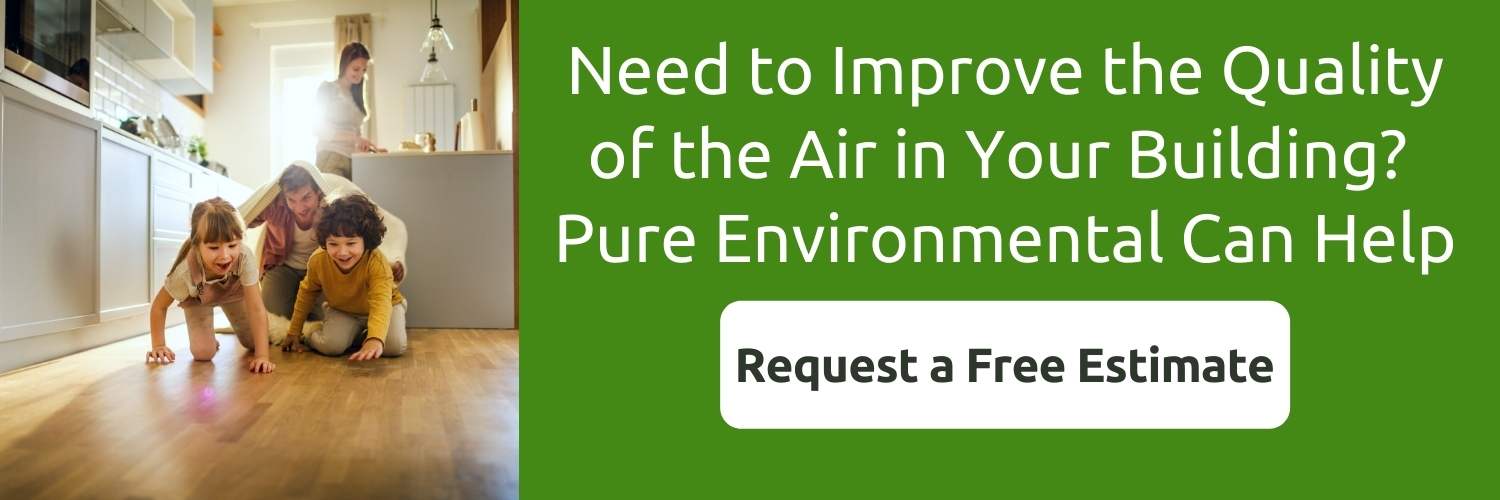You didn’t think much of it when you started getting headaches, extreme fatigue, and muscle aches the first week at your new job.
It was just the stress of your new position, right?
But now that it’s still happening two months later, you are starting to wonder — and the more you think about it, you realize that you only feel awful when you’re at work.
Could you be suffering from sick building syndrome?
Learn about the symptoms and causes of sick building disease and how improving the quality of the air you breathe may be the solution you’re looking for.

Table of Contents
- What Is Sick Building Syndrome?
- What Are the Symptoms of Sick Building Syndrome?
- How Is Sick Building Syndrome Diagnosed?
- What Are the Main Causes of Sick Building Syndrome?
- How to Identify the Source of Sick Building Syndrome
- What Are Some Solutions for Sick Building Syndrome?
- Need To Improve the Quality of the Air Inside Your Home or Business? Contact Pure Environmental for Help
What Is Sick Building Syndrome?
Sick building syndrome, a.k.a. sick building disease, is a term used to classify buildings that are unhealthy for their occupants.
The problem may be the result of a wide variety of factors, including
- Poor ventilation
- Lack of maintenance
- Faulty construction
- Mold
- Improper building materials; or
- Contaminated building materials
What Are the Symptoms of Sick Building Syndrome?
According to the Centers for Disease Control’s National Institute for Occupational Safety and Health, sick building syndrome is their most commonly received building-associated complaint.
The symptoms of sick building disease are vast, and may include:
- Ear, nose, and throat irritation
- Cold and flu-like symptoms
- Coughing and sneezing
- Foggy thinking
- Anxiety and depression
- Achy muscles
- Fatigue
- Headaches
- Dizziness
- Nausea
- Difficulty concentrating
- Chest tightness
- Asthma
- Skin irritation; and
- Rashes
How Is Sick Building Syndrome Diagnosed?
The distinguishing factor of the above complaints is that they occur when a person is occupying a specific building — and frequently resolve within minutes to hours of them leaving the location.
There is no one-size-fits-all diagnostic test for sick building disease.
There may be visual clues, such as mold growing on a wall or the realization that you just don’t feel like yourself when you are in a specific building.
If you go to the doctor for sick building syndrome, they will most likely use a process of elimination to rule out conditions such as:
- Asthma
- Allergies; or
- Other illnesses
They may also ask you about your home or work environment.
You may find that keeping a journal of your symptoms can help you figure out the source of your discomfort. To do this, you’ll simply keep track of:
- The specific symptoms you’re feeling
- Your location; and
- The time your symptoms begin and subside
This detailed information will be helpful to your doctor and environmental professionals, such as Pure Environmental, should you find you need to enlist their help to clear up the issues at your home or business.
What Are the Main Causes of Sick Building Syndrome?
While there are many theories as to the causes of sick building syndrome, the most commonly noted include:
- Water damage that leads to mold infestation
- Gas contaminates, like carbon dioxide, carbon monoxide, and ozone
- Chemical contaminants from furniture, carpet, flooring, cleaning products, automobile products, etc.; and
- Poor air ventilation
#1: Water Damage
Did a broken pipe cause flooding in your home?
Maybe you had an unknown leak in your roof or behind a sink that resulted in damage within your walls.
The insides of our homes and buildings are filled with all sorts of materials, including:
- Walls
- Furniture
- Flooring; and
- Carpet
If these items become wet and do not dry out properly, your home can easily become infested with mold.
Mold spores can attach to clothing, furniture, and pets and are then easily inhaled, causing:
- Breathing problems
- Allergies
- Aspergillosis
- Skin and eye irritation
- Fever
- Fatigue; and
- Headaches

#2: Chemical or Gas Contaminants
Chemicals are found throughout homes and buildings, including in:
- Vinyl flooring
- Carpet
- Cleaning products
- Furniture
- Air fresheners
- Gasoline and automotive products
- Paint; and
- Adhesives
These chemicals may emit volatile organic compounds or VOCs. While there are many VOCs, one of the worst ones out there is formaldehyde.
At low levels, the day-to-day breathing of formaldehyde can irritate your:
- Eyes
- Nose; and
- Throat
But at higher levels, formaldehyde exposure may cause:
- Shortness of breath
- Skin rashes
- Wheezing
- Lung problems; and even
- Cancer
#3: Poor Air Ventilation
In past years, most homes were specifically built to be buttoned up airtight.
And while this was great for energy efficiency, the reality is that it wound up creating all sorts of problems. While you may have been saving money on your gas and electric bills, your home became a stagnant environment filled with air that wasn’t able to “breathe” by letting inside air out, and outside air in.
In many cases, this lack of ventilation is at the root of sick building syndrome.
If you have a building that already has issues with something such as mold or chemicals and your ventilation system is …
- Poorly installed
- Poorly maintained; or
- Isn’t delivering enough air exchange
… you’ll be compounding the problem and the resulting air may be detrimental to your health.
#4: Pest Problems
Pests are everywhere outside of our homes, and typically don’t pose any problems — they’re in their natural habitat. It’s when they decide to make their way inside that it causes a problem.
Pests can contribute to sick building syndrome by …
- Bringing in foreign materials to use as food or nesting
- Dander from their bodies, skin sheddings, or hair
- Contributing to moisture issues
… creating an unhealthy environment for humans.
How to Identify the Source of Sick Building Syndrome
If you think you may be suffering from sick building syndrome, it’s critical that you contact professionals, like Pure Environmental, who have experience dealing with the problem.
You’ll also need to gather data.
You will want to ask plenty of questions to get as much information as possible, inquiring about things such as:
- Is there an odor? If so, is it an organic smell or more of a chemical odor? Is it constant, or does it come and go? Do you notice it in every room of the building, or just one or two? Is there something being manufactured in the space that may be causing the odor?
- Is there a visual concern, such as obvious mold?
- How many people are complaining about feeling sick?
- Is there a certain time of day or night that symptoms appear or seem to get worse?
The experts at Pure Environmental will be able to use the data you collected to hone in on the possible solutions.
By evaluating the answers to these questions, they will be able to determine if testing needs to be done — and if so, what type?
While testing can be very helpful, it can also be very expensive, especially if you don’t know what you’re testing for. That’s why your research is so vital.
The specific chemical compounds or contaminants that are present are key pieces in the puzzle of determining what the next step will be.
As the next step, they may check the building’s:
- Carbon dioxide levels (CO2)
- Carbon monoxide levels (CO)
- Relative humidity; and
- Ozone levels
This will give them a quick snapshot of whether the problem stems from a …
- Mold problem
- Chemical issue; or
- Lack of ventilation
… and which course of action to pursue.

What Are Some Solutions for Sick Building Syndrome?
The best solution for sick building syndrome is the removal of all air and surface contaminants with an air filtration system, such as Pure Environmental’s PurAyr technology.
PurAyr utilizes a scientific process known as Advanced Oxidation Process (AOP) that uses the internal reactions between UV light and titanium dioxide nanoparticles to safely eliminate …
- Airborne
- Surface; and
- Embedded organic
… contaminants.
Some additional ideas for coping with sick building syndrome in the meantime include:
- Taking regular outside breaks
- Opening the windows to let fresh air inside; and
- Being cautious with indoor chemical use
Need to Improve the Quality of the Air Inside Your Home or Business? Contact Pure Environmental for Help
If you think you are suffering from sick building syndrome, Pure Environmental can help.
All of our technology is:
- Environmentally friendly
- Non-toxic; and
- 100% green
Plus, our workers and company are licensed and insured in the states we operate in.
Not only are we the experts in sick building syndrome, but we also specialize in:
- Odor removal
- Bedbug inspection and removal
- Mold remediation
- Air filtration; and
- Disaster restoration
If you’re ready to get to the root cause of your indoor air problems and make your environment pure again, get in touch with the professionals at Pure Environmental today.
Recent posts
- Home Insurance During Renovations: What Is Covered and What To Know Before Getting Started
- Mitigation and Restoration: Understanding the Difference Between the Two and Why They’re Both Necessary
- Should You Stay or Should You Go? Know When To Walk Away From a House With Mold
- How To Get Rid of Weed Smell: Top Tips To Help Cannabis Users and Growers Keep Their Homes Smelling Fresh and Clean
- HVAC System Longevity and Understanding When It’s Time To Replace Yours
